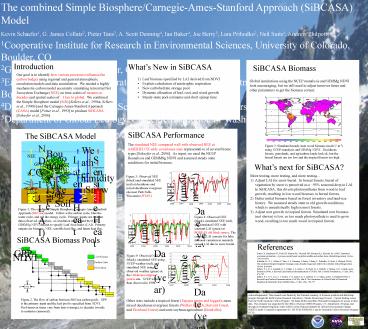The combined Simple BiosphereCarnegieAmesStanford Approach SiBCASA Model - PowerPoint PPT Presentation
1 / 1
Title:
The combined Simple BiosphereCarnegieAmesStanford Approach SiBCASA Model
Description:
1Cooperative Institute for Research in Environmental Sciences, University of ... Explicit calculation of autotrophic respiration. New carbohydrate storage pool ... – PowerPoint PPT presentation
Number of Views:23
Avg rating:3.0/5.0
Title: The combined Simple BiosphereCarnegieAmesStanford Approach SiBCASA Model
1
The combined Simple Biosphere/Carnegie-Ames-Stanfo
rd Approach (SiBCASA) Model Kevin Schaefer1, G.
James Collatz2, Pieter Tans3, A. Scott Denning4,
Ian Baker4, Joe Berry5, Lara Prihodko3, Neil
Suits4, Andrew Philpott4 1Cooperative Institute
for Research in Environmental Sciences,
University of Colorado, Boulder, CO 2Goddard
Space Flight Center, Greenbelt, Maryland 3Earth
System Research laboratory, National Oceanic and
Atmospheric Administration, Boulder,
CO 4Department of Atmospheric Science, Colorado
State University, Fort Collins,
Colorado 5Department of Global Ecology, Carnegie
Institution of Washington, Stanford, CA
Introduction
Whats New in SiBCASA
SiBCASA Biomass
Our goal is to identify how various processes
influence the carbon budget using regional and
general atmospheric circulation models and data
assimilation. We needed a highly mechanistic
carbon model accurately simulating terrestrial
Net Ecosystem Exchange (NEE) on time scales of
minutes to decades and spatial scales of 1 km to
global. We combined the Simple Biosphere model
(SiB) Sellers et al., 1996a Sellers et al.,
1996b and the Carnegie-Ames-Stanford Approach
(CASA) model Potter et al., 1993 to produce
SiBCASA Schaefer et al., 2006.
- Leaf biomass specified by LAI derived from NDVI
- Explicit calculation of autotrophic respiration
- New carbohydrate storage pool
- Dynamic allocation of leaf, root, and wood growth
- Steady-state pool estimates and short spinup time
Global simulations using the NCEP reanalysis and
GIMMg NDVI look encouraging, but we still need to
adjust turnover times and other parameters to get
the biomass correct.
NEE Respiration GPP
SiBCASA Performance
The SiBCASA Model
The simulated NEE compared well with observed NEE
at AMERIFLUX eddy covariance sites representative
of several biome types Schaefer et al., 2006.
As input, we used the NCEP Reanalysis and GIMMSg
NDVI and assumed steady state conditions for
initial biomass.
NDVI (LAI)
Figure 3 Simulated steady state wood biomass
(mole C m-2) using NCEP reanalysis and GIMMg
NDVI. Deciduous forests, grasslands, and
agriculture lands look ok, but the boreal forests
are too low and the tropical forests too high.
Weather
Boundary Layer
Canopy Air Space
NEE
Latent Heat
Sensible Heat
GPP
Whats next for SiBCASA?
Canopy
Temperature
CO2
R
Humidity
- More testing, more testing, and more testing
- Adjust LAI for snow burial. In boreal forests,
burial of vegetation by snow is perceived as a
95 seasonal drop in LAI. In SiBCASA, this
diverts photosynthates from wood to leaf growth,
resulting in low wood biomass in boreal forests. - Better initial biomass based on forest inventory
and land-use history. We assumed steady state or
old growth conditions, which is unrealistically
high in most forests. - Adjust root growth in tropical forests. Simulated
root biomass (not shown) is low, so too much
photosynthate is used to grow wood, resulting in
too much wood in tropical forests.
Figure 3 Observed NEE (black) and simulated NEE
(red) at deciduous and mixed deciduous/evergreen
site near Park Falls, Wisconsin (WLEF)
Snow
Moisture
Temperature
Carbon
Soil
Figure 1 The combined Simple Biosphere-Carnegie-A
mes-Stanford Approach (SibCasa) model. Yellow is
the carbon cycle, blue the water cycle, and red
the energy cycle. Primary inputs are weather
data (observed, reanalysis, or circulation model)
and the 8 km GIMMSg NDVI dataset to specify Leaf
Area Index (LAI). Primary outputs are biomass,
NEE, sensible heat flux, and latent heat flux.
Figure 4 Observed NEE (black), simulated NEE
(red), and simulated NEE with constant LAI
(green) at BOREAS old black spruce. The constant
LAI corrects for false seasonal variation in
remotely sensed LAI due to snow burial.
SiBCASA Biomass Pools
References
GPP
NDVI
Potter CS, Randerson JT, Field CB, Matson PA,
Vitousek PM, Mooney HA, Klooster SA (1993),
Terrestrial ecosystem production - A process
model based on global satellite and surface data,
Global Biogeochem. Cycles, 7(4),
811-841. Schaefer, K., G. J. Collatz, P. Tans, A.
S. Denning, I. Baker, J. Berry, L. Prihodko, N.
Suits, A. Philpott (2006), The combined Simple
Biosphere/Carnegie-Ames-Stanford Approach
(SiBCASA) Model, Global Biogeochem. Cycles, in
review. Sellers, P. J., D. A. Randall, G. J.
Collatz, J. A. Berry, C. B. Field, D. A. Dazlich,
C. Zhang, G. D. Collelo, and L. Bounoua (1996), A
Revised Land Surface Parameterization of GCMs,
Part I Model Formulation, J. Clim., 9(4),
676-705. Sellers, P. J., S. O. Los, C. J.
Tucker, C. O. Justice, D. A. Dazlich, G. J.
Collatz, and D. A. Randall (1996), A Revised Land
Surface Parameterization of GCMs, Part II The
Generation of Global Fields of Terrestrial
Biophysical Parameters from Satellite Data, J.
Clim., 9(4), 706-737
Figure 9 Observed NEE (black), simulated NEE
using NCEP weather (red), and simulated NEE using
observed weather (green) at the Oklahoma
tallgrass prairie site. NCEP is drier than
observed in 1998.
CWD
Acknowledgements This research was funded by the
National Academy of Sciences postdoctoral
fellowship program through the Earth System
Research Laboratory, Climate Monitoring Division.
Current funding comes from the North American
Carbon Program. We thank all the Ameriflux
Principal Investigators for access to their data.
This research was supported by the Office of
Science (BER) Program, U.S. Department of Energy,
and through its Southeast Regional Center (SERC)
of the National Institute for Global
Environmental Change (NIGEC) under Cooperative
Agreement No. DE-FC02-03ER63613, and its
Terrestrial Carbon Processes Program (TCP).
Figure 2. The flow of carbon between SibCasa
carbon pools. GPP is the primary input and the
leaf pool is specified from NDVI. Pool turnover
times vary from days (storage), to decades
(wood), to centuries (armored).
Other sites include a tropical forest (Tapajos
prime and logged), more mixed deciduous/evergreen
forests (Walker Branch, Harvard Forest, and
Howland Forest) and corn/soybean agriculture
(Bondville).































